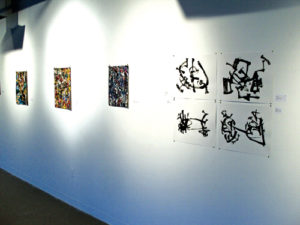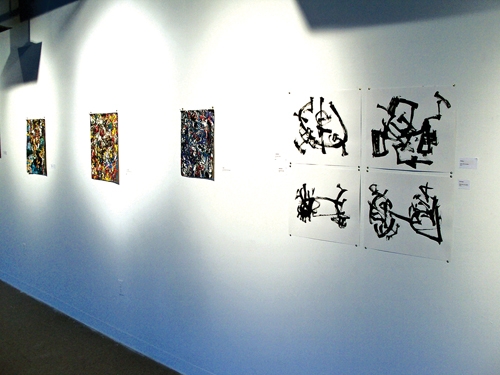Brandon Kennedy’s abstract exhibition Redeemer/Ideal severs the ties between art and socio-political commentary
Dillon Aubin
Staff writer
@excalweb

Last week, second-year fine arts major Brandon Kennedy presented his debut art exhibition Redeemer/Ideal at the Eleanor Winters Art Gallery. Consisting of 16 original works, the exhibition was displayed between January 31 and February 3.
Kennedy creates his work spontaneously, a practice he calls “automatism.”
“You don’t exactly know what you’re going to produce,” he says. “You just go with the flow. You don’t know what the end result is going to be. It’s automatic.” This approach to artistic expression was apparent, which featured extensive use of colour layering and abstract imagery. He works primarily with acrylic paints and inks.
“I am really experienced with acrylics, so it’s kind of natural for me to use them,” he explains. The use of these materials makes it easier to control the paints and permits more artistic freedom.
Kennedy cites Jean-Paul Riopelle and Jackson Pollock as his two main influences for this exhibition. Both artists arrange colours in a pure abstract form. As a Canadian, Brandon expressed a personal connection to Riopelle because of his artistic identity as an obscure Canadian painter; Jackson Pollock, a more famous artist made known for hurling paint on canvases, was inspirational for his radical ideas and contributions to modern art.
“The whole point of the exhibition was to show that there was an intellectual discipline to concrete abstraction,” he explains. “There’s more to it than just putting paint on a canvas. You really have to understand why you’re putting the paint on the canvas.” Critics of abstract art often dismiss it as simply throwing paint around a studio, but abstract artists put serious thought and contemplation into the materials and colours they use.
The rapid spontaneity of abstract art lies in the actual act of painting, not the ideas behind the art. Kennedy expressed strong intentions to separate his art from political and social commentary.
“I wanted to deal with the art specifically as art,” he says. “I wasn’t using art to say anything about anything else.”
The exhibition consisted of works entirely removed from anything outside of the art itself. In the language of art, the statement exists harmoniously, but cannot be translated. There is enough theory, intellect, and creativity in pure abstraction for it to exist on its own.
Upon first glance, the exhibition is visually stimulating. Viewers instantly get a sense of chaos within the paintings, and see that they were arranged from a free, improvisational method. The disorder within the art gives a tasteful level of intensity and presents a thick, complex image.
But after a closer look, viewers can see the intelligence and structure behind the artistic anarchy. Though the image may seem randomly generated, extended analysis reveals that the colours were chosen and applied with consideration. Kennedy recognizes that pure improvisation doesn’t always lead to good quality.
“You can imagine it’s very easy to make a bad painting or a lot of mud,” he says. The colours in his paintings seem to be chosen specifically to complement each other and to add an intellectual element to concrete abstraction. The combination is effective: a perfect blend of order and chaos.
Kennedy plans to visit more galleries both around campus and the city of Toronto. Though Redeemer/Ideal was an impressive debut, the artist intends to create more collections of art and improve his automatic style. If all goes well, the fine arts community will become familiar with Kennedy’s brand of improvised chaos.


